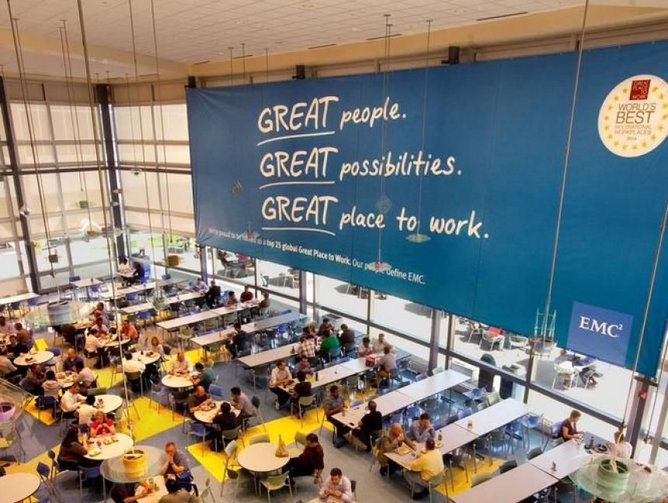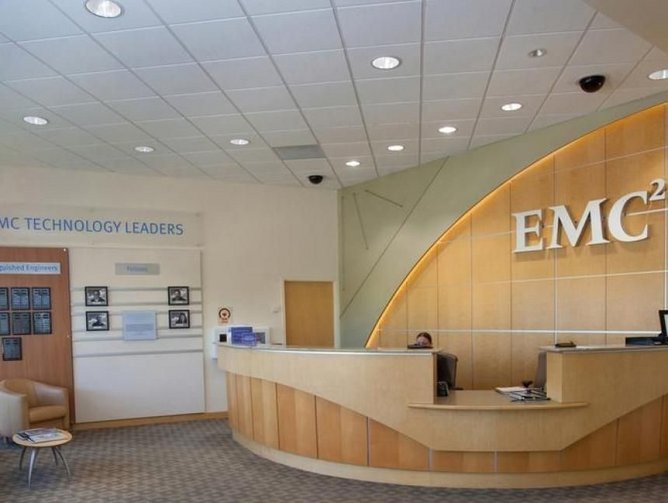“As a company our key role is providing essential Technology for our customer’s organisations to build their digital futures, to transform IT and protect their most important assets other than their people, their information,” says Marc O’Regan, CTO - Dell EMC Ireland.
Dell EMC, which operates under the larger Dell Technologies company, enables its enterprise customers’ IT and digital business transformations through hybrid cloud and big data solutions.
Recently it was announced that the two companies, Dell and EMC would merge in the biggest merger in the history of IT. Through the merger, Dell EMC incorporated the two company’s capabilities and portfolios, sales teams and R&D departments to establish itself as the technology industry’s leading advisor to Enterprise and Commercial companies in all sectors all over the world.
Architecture of change
Prior to the merger, O’Regan has worked in a number of technology development roles, before moving towards a focus on cloud computing and cloud based analytics. His background is in High Performance Computing, which later took him into “Cloud Computing” and Data Analytics, harnessing his skills and experience in “Grid Architectures”. In his current role as CTO, O’Regan sees himself as an architect of end to end solutions.
“My job really is to articulate our company's point of view of our technology for our customers, partners and to architect, develop and design solutions for customer’s right across the broad spectrum of our portfolio,” he says.
Dell has been one of the world’s leading technology solutions providers, most notably in the End User compute/PC and Server market. O’Regan believes that this presented a challenge for Dell, as people would think of Dell purely as a laptop or server provider – as opposed to End to End solutions provider.
“The company developed those technologies wonderfully well but there's certainly much, much more than that,” he says.
EMC falls into a similar category, referred to on the surface as just a hardware storage provider, despite developing and acquiring a series of technology solutions that are predominantly Software based, and aligning Dell EMC in this regard, is something that excites O’Regan looking forward.
“EMC has made some of the most interesting and relevant storage solutions across the industry to this day, but we work with more than just hardware technology and I think that’s what makes it so exciting about this coming together with Dell,” says O’Regan.
“At EMC, our heritage is deeply steeped in Engineering. And with Dell we inherit the position of pioneers of Technology commitments to Open Standards such as x86 and Software Defined Networking”
The merger with Dell to become Dell EMC represents a turning point in the technology solutions industry.
“This forcers our partners, our customers and the whole industry to look at the company in a very different way,” says O’Regan.
Dell EMC will now be looked upon as an end to end service provider, from edge to core to cloud based solutions.
Navigating the digital space
Dell EMC provides core infrastructure, technology, connectivity and capacity in what O’Regan sums up as “servers, networking and storage”. The company also offers the cloud and visualisation business VMware as well as RSA, which is a security and data protection arm of the business.
How the company strives to provide this, is through enabling customers to become a digital business. Dell EMC enables its customers and enterprises to build digital business, transforming through “trusted Hybrid Cloud structure while using Big Data and analytic solutions through modern data centre architectures”.
“We take that and incorporate industry leading converged architecture, compute network and storage, wrapping it into cyber security and data protection technologies as well,” says O’Regan.
In the journey to becoming the technology industry’s most trusted advisor, Dell EMC will provide capabilities across the continuum of the industry, incorporating strategy, development, consulting services and Application and Software Development solutions.
The technology industry is currently in what O’Regan describes as an “explosive place” at the moment, explosive in the sense that it is being dominated by a multi cloud focus and the turn towards digital transformation.
“The market right now is all about digital transformation, looking at Big Data and Big Data structures and really using analytics to drive for better results from and insights into the data,”
He adds - “Our market is dominated by multi Cloud, Digital transformation is core to what all business models are trying to achieve, and Big data and analytics is driving the behaviour of the enterprise. The IT org has to change, the people and process within the organization needs to change to compete and survive and all of this becomes kind of terrifying when you attempt to articulate, or paint a picture like this.
We try and put all of this into context, and remember, its not just the industry and the customer community that is changing, but the vendor and partner community is changing also, so the entire industry as a whole is being disrupted and its important and incumbent upon us to make sure that the customer knows that we are with them on this disruptive journey”.
This explosive place has forced organisations like Dell EMC to look at its current position today, with regards to technology solutions and where the company is heading over the next decade and beyond. This, O’Regan believes, is why it made sense for Dell and EMC to come together.
“Some of the dynamics of the industry are playing into our hands. Specifically, our customers’ organisations have to respond to this explosive change and it’s a big change in the way things work,” says O’Regan.
Technology, O’Regan says, is only a small part of this explosive change. Dell EMC recognises that the people and process of these customer organisations need to change to compete and survive. This need is addressed by Dell EMC as the very culture of the company is to unify in an attempt to articulate and paint a “road map” of understanding for its customers.
Disruption by design
Disruption and transformation can be seen as a negative thing. In an industry where the need to change and transform is a means to survive, it is important for Dell EMC to work with its customers to better serve them.
“The entire industry as a whole has been disrupted and it's really important for us to make sure that our customers know that we're with them all of the way on this disruptive journey and that change doesn't always necessarily have to be a bad thing,” O’Regan explains.
The company achieves this through the Dell EMC umbrella of different companies all with different capabilities within each organisation. Through Dell EMC and Dell Technologies, the company is better optimised to address customers’ transformative challenges.
The challenge of change
Disruption and transformation naturally brings challenge and Dell EMC is not without its challenges. O’Regan identifies the challenges the company faces as two fold. Firstly, challenge from a technology perspective – specifically, the need to IP new technologies and distribute them out to customers and the IT capacity to do so.
“The challenges as I see it are 2 fold. The first is technology. We have to build new technology, such as Cloud native applications, data lake environments, and simplify how all of these things are deployed so that we have enough IT capacity to navigate this, so there is a technology thread that is addressed as part of the challenge, so we need to simplify how new technologies are deployed out to our customer ecosystem,” says O’Regan.
Secondly, as with any digital transformation, there is people and process, cultural change. To compete and survive, customer organisations need to modernise and transform, but adopting new technologies and ways of working can prove difficult.
“In this I mean that the IT organization itself needs to modernize, so we are going to have to get skilled up and used to new technologies that we are going to have to become very literate on such as new programing language, and DevOps operational models.
It’s about adopting a new way of working and a new cultural process and for me that's one of the hardest things to do,” O’Regan continues.
“The impact of transformation to the end user, is really everything. The end user is looking for a Data driven, real time, and personalized 1:1 relationship experience from IT, and IT traditionally can’t do that today, so all of these disruptive technologies and architectures and Cloudification are part of the transformation toolset if you will. So this is a very big aspirational goal and the aspiration is very clear with the customer and the end user, and if we don’t achieve it, they’ll simply go somewhere else to achieve it”.
The customer at the centre
In a world where technology is advancing more than ever, keeping what the customer needs are with regards to IT and technology is crucial to Dell EMC.
“We're razor focused on our customers. The culture of Dell EMC is the ability to listen, to understand and to apply technology platforms and technology solutions to be able to help our customers,” says O’Regan.
The very goal of Dell EMC is focused on the customer and new technology to enable customer and human progress.
“We're committed to bringing technology innovation to our customers right across the world so they can transform and thrive in their new digital economy,” O’Regan adds.
“Technology is changing rapidly, and sometimes at a pace that makes it difficult for even the builders and developers of advanced IP to keep up.
For instance, we develop State of the art infrastructure and technology that we make available to our wide audience arena, from SMB right up to corporate Enterprise and these technologies need to bring differentiation and add true value to what our customer is trying to achieve
We also develop technology, made available from our deep and wide Software and Hardware portfolio that is built to a specific standard for a specific industry or vertical type, such as Telecommunications, oil & Gas and E&P etc.
The good news is that customers, large or small, specific or generic in their delivery and consumption of technology have access to this technology and to this, we are ferociously committed”
A digitally connected world
O’Regan’s position as CTO allows him to identify incoming trends within the industry, be it digital transformation, disruption or the increased role of IoT.
“When thinking about our organization and what makes us tick, what makes us relevant and why I love working here, my conclusion on where Dell EMC are relevant and how we differentiate, is that we are many, many more things then just a Hardware technology vendor, we have to navigate a much more complex ecosystem, so the amount of skills and resources available at Dell EMC, as well as the technologies that we have IP’d and/or acquired over the last number of years, are incredibly relevant to what’s going on in industry over the next decade, decade and a half and possibly beyond, so as a technologist wanting to architect and build things, that’s kind of a cool place to be”
So what’s keeping the CTO’s and CIO’s up at night, and what exactly is this Digital Transformation and how does it hold its relevance to the typical Dell EMC customer today and going forward?
“So there are big megatrends, we see convergence and divergence all of the time, across all types of industries and we are seeing the greatest explosions in these spaces. So it may sound like an Oxymoron, but it’s really routed in getting comfortable with the fact that change can be good – As a CTO or CIO, I have to look at mobile devise usage and consumption, I have to think about learning and developing on new technology, a new ecosystem, you can’t control the new partner ecosystem, I have to be good with consumption of technologies that I don’t own, that to some degree I can’t control, and if I look at using acyclic tools, then perhaps we can !”
He adds: “Enterprises traditionally tend to be evolutionary and not revolutionary and there is a conservative nature in IT. That said, there is a clear understanding, from what I see, that these new tools and technologies are inevitabilities, they can be useful and we really need to go navigate them, sooner rather than later. This is how we achieve what I call “Disruptive evolution” in the sense that, we haul our existing technology form the new world and make it compatible with the old-world, this is tough, as it forces us to rethink how we architect, rethink how we platform for new and existing applications and data sets, and it’s all about forward evolution,… a kind of loving and leaving going on at the same time”.
This is indeed all good and well. But what of the investment already made in the Datacenter and where is the focus from a Dell EMC point of view here?
“It’s in the application” says O’Regan. “it’s all about the Application - So a good example of this would be when we mobilize storage going forward – so, we now have access to and visibility of all of this centralized data, where am I going to store all of this information. First thoughts are, well I have a state of the art Storage Area Network, perhaps built on VMAX architecture or similar, this is the obvious place to store & scale the information – so, you can do this, but most of the mobile or new apps that you’re now building, require S3 or Object interfaces, or restful API. So now you’re thinking, do I throw out my Traditional Scale Up Storage System to make room from my new Scale out environment? Well… No – we say that you deploy your new scale out engineering and absolutely move some existing workloads from the old world into the new, however, critical apps that were written to a scale up on a vertical structure will remain on the “Monolith” on the scale UP architecture that was specifically designed to handle these workloads. This is a disruptive evolution as you now have new architecture that is compatible with your old world platform and you can roadmap your next “Mobile workload” deployment onto the new Scale Out platform while still servicing the Traditional Apps accordingly
He also has projections that indicates there will be around 38 billion connected devices by the end of the next decade, and with that level of connectivity comes an increased access to data.
With such volumes of data inevitably comes the question of the security of that data.
“We’re more connected than we’ve ever been before which means we are more at risk than ever before,” says O’Regan.
Dell EMC strives to safeguard through that risk by working to become better informed on threat intelligence. Through the use of algorithms designed in house, the company can better understand the threat that comes from handling high volumes of data moving from data centre to cloud, exposing the IP by adopting Continuous Integration and Continuous Development as part of the App Dev experience.
“By working to understand the threat that comes within our network we can make more informed decisions, analyse predictability and defend against cyber risk more efficiently.”
The merger of Dell EMC, as stated by O’Regan, represents the current explosive and disruptive nature of the data technology industry. The increase in focus on data storage and analytics is something that O’Regan believes all company’s must and will adopt to better serve the ultimate goal, the customer.
“We are going into this digital, cloud-native world where it's not enough to just to store and protect information anymore. We need use information to better serve our customers, we need to help our customers use information to better serve themselves and we need to use information to better serve people right across the world where possible,” he concludes.




